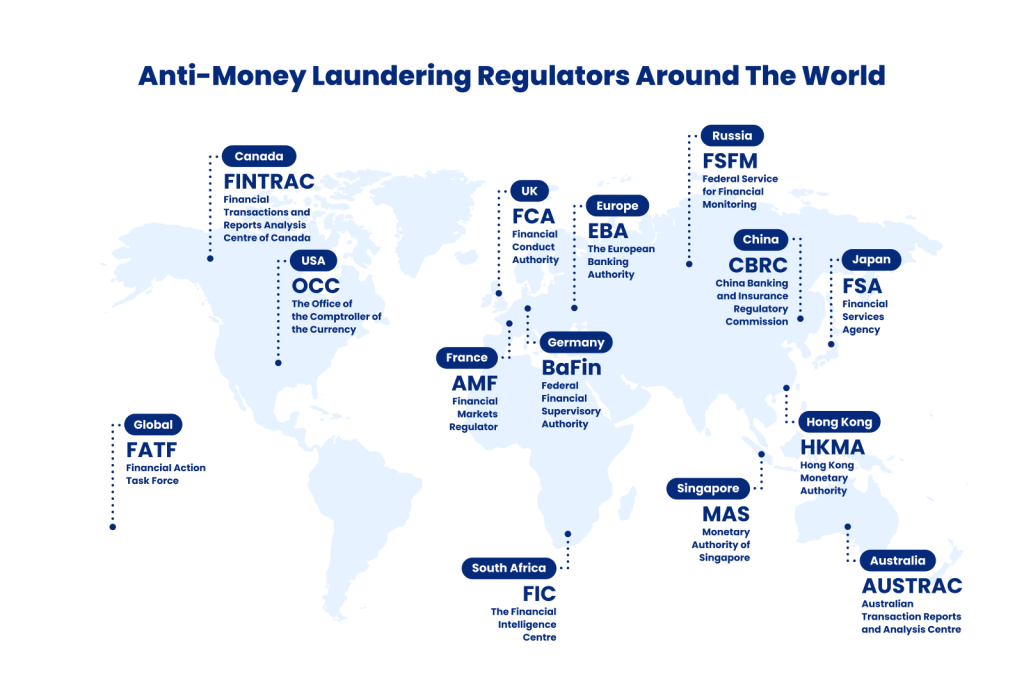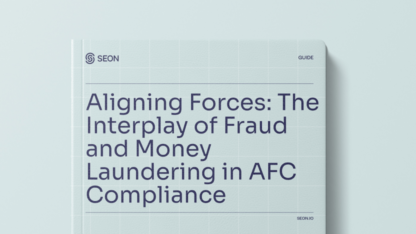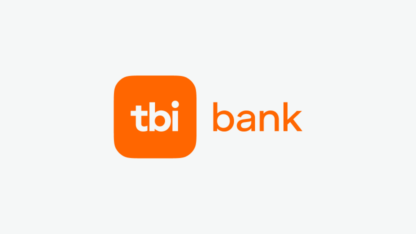Financial crime is so common that it even has its own techy abbreviation: FinCrime. But whether you use this neologism or avoid it, financial crimes are a huge concern to both financial and other organizations, and can result in massive losses.
One of their worst qualities? The fact that government-issued penalties add insult to injury, with $9.95 billion awarded in fines around the world in 2021 and, even more impressively, $22.86 billion in 2020.
Organizations on the receiving end of these are seen as responsible for allowing this to take place on their platforms – be it deliberate or not.
Knowledge is power, however. So let’s learn more about financial crime and how it is tackled.
What Is Financial Crime?
Economic or financial crime is an umbrella term that encompasses every type of criminal conduct that is linked to financial entities and markets, including banks, fintech companies, lenders, and so on. Additional examples often seen in recent years include pyramid schemes and pump-and-dumps affecting exchanges and retail investors.
A type of financial crime that immediately comes to mind is money laundering, which is a huge concern for everyone in the sector, as well as legislators. As defined by the UK’s Financial Conduct Authority, financial crime can involve any type of dishonesty or fraudulent behavior, as well as misconduct and misuse of information, terrorism financing, and handling criminal proceeds.
Financial crime can have many a victim, including:
- banks and neobanks
- fintechs of any type
- private individuals or groups of individuals
- public and private companies
- the government or other authority
- the economy at large
Because of the ripples every instance of financial crime can send through the economy, legislators are especially vigilant about addressing it, as we’ll see below.
SEON works with real-time data, enriching it to help you identify customers’ true intentions and stop mules and fraudsters in their tracks.
Ask an Expert
The Main Types of Financial Crime
Because it’s such a wide definition, almost all crime targeting financial organizations is financial crime in one way or another. In fact, sometimes this term is used to refer to all fraud that is related to money schemes, and thus encompasses an even wider range of behaviors.
Some key types include:
- money laundering
- tax evasion
- embezzlement
- forgery and counterfeiting
- identity theft
- bribery and corruption
- terrorism financing
- wash trading and pump-and-dumps
- market abuse and insider trading
The perpetrators of financial crime can be external, internal or a combination of the two. In a 2021 survey by PwC, 43% of the main perpetrators of disruptive financial fraud were external, 31% were internal and 26% of the cases were a result of collusion.

Financial Crime Trends: Is It Becoming More Dangerous?
It is believed by experts that the risk of financial crime has skyrocketed in recent years. In fact, the United Nations UNODC estimates that less than 1% of criminal funds flowing through the financial systems of the world are ever caught.
The numbers were already concerning. But add the effects of a two+ year global pandemic, when criminals pooled their resources to find new ways to defraud organizations and individuals, as well as the overall financial landscape and looming crisis, and there has never been more appetite nor more opportunity for financial crime.
The rise in neobanks and challenger banks also fuels these figures. Neobank customers are expected to become 25% of the banking public within the next half decade, while legacy financial organizations are also embracing the digital, offering up quick mobile or web-based onboarding and, with it, several new pathways for fraudsters to take advantage of.
Finally, we ought to mention the rise and rise of cryptocurrencies and other decentralized ownership systems such as NFTs and the so-called metaverse, which bring with them brand new ways for financial crime to be conducted, as well as for proceeds to be laundered.
Financial Crime and Money Laundering
Addressed by what is known as AML (anti-money laundering) measures, money laundering or layering in banking and other sectors is a crime whose importance to the global economic system cannot be understated.
It is virtually impossible to separate money laundering from financial crime because almost all financial crime is bound to lead to funds being stolen or proceeds generated – which will then have to be laundered, in addition to the fact that money laundering is financial crime in itself.
The sources of funds funneled into money laundering schemes are known in legal terms as “predicate offenses” and include drug trafficking, robbery, insider trading, robbery, identity theft and so on – pretty much everything that will bring the criminals some money.
This is why money laundering is such a mainstay in discussions about financial crime: It enables hundreds (if not thousands) of other types of fraud and scams. Consequently, authorities and legislators put immense pressure on institutions to block and catch money mules and fraudsters.

Measures to Battle Financial Crime
International as well as national authorities attempt to battle financial crime through research and legislation, which mandates specific types of organizations, such as banks, estate agents and iGaming companies, to know who they are dealing with. It also holds them accountable for allowing financial crime to be perpetrated on their platforms.
On the companies’ side, strategies, solutions and individual tools to combat economic crime abound, and tend to belong to several different categories:
KYC and onboarding tools: When a customer first signs up for an account or product with a financial organization, the latter is mandated to run tests to confirm the customer’s identity. This is called the Know Your Customer (KYC) step, and is assisted by specialized software.
Identity verification software: IDV for short, this type of preventative measure aims to either automatically or manually verify the customer’s identity by examining the validity of the evidence they have presented at KYC. In the online world, this can take on the form of a video call with a specialist or algorithms that investigate scanned passports and the like.
Transaction monitoring & AML software: According to AML legislation, banks and neobanks have to do due diligence on their customers. Part of this is monitoring their transactions for any over a set minimum amount (e.g. $3000 in the US), as well as other Due Diligence (CDD) and Enhanced Due Diligence (EDD) measures, which change from country to country.
End-to-end risk/fraud prevention: Software built to identify and prevent fraudulent behavior can assist in battling financial fraud. Depending on its features and the complexity of the landscape where it’s deployed, this can be used on its own or as part of a wider risk stack.
Authentication protocols: To avoid account takeover attacks (ATOs) that would enable the attacker to commit economic crimes and financial fraud, financial organizations employ strong authentication protocols. These check if the person who is logging in is the legitimate owner of the account, and can include biometrics such as fingerprint and voice recognition, 2FA, etc.
Compliance suites: This type of solution will address organizations’ compliance obligations and concerns, ensuring minimal risk of hefty fines and the ability to operate in different locales without any issues.
Risk monitoring: More of a framework than a specific tool, risk monitoring is an ongoing process where companies at high risk of being attacked or becoming unwilling accomplices to economic crimes monitor and review their risk prevention strategies as they go.
Make use of SEON’s data enrichment and AI capabilities to identify financial fraud and scams and keep your operations and customers safe.
Ask an Expert
How Should a Company React to Suspected Fraud?
A company that identifies an instance of financial or other fraud before or as it is happening is much better placed to mitigate it than a company that only realizes after the fact.
Suspected fraud is often reacted to by blocking the user from completing their transaction. If the company is confident enough that this is a bad actor, or if its risk tolerance is particularly low, the user is locked out of their system or even blacklisted as well.
Overall, when a company suspects a financial crime of any type, it is likely to conduct an investigation into what happened, how it happened, and how to mitigate against future occurences – often with the assistance of fraud investigation software.
In all the above cases, learning from the incident is key. Whether this amounts to updating one’s fraud prevention software, installing failsafes at various touchpoints, or even adapting an internal process altogether, investigations ought to result in changes and improvements to your risk strategy.
Catching criminals in your systems is great, but it helps to be proactive as well.
How Can SEON Help Stop Financial Crime?
As a fraud prevention company, SEON sits firmly at the cusp of robust security and user-friendliness – both for its own customers and yours.
While there are powerful algorithms gathering data to mitigate fraudsters, these work under the hood with minimal disruption to the customer journey, giving you a leg up against the competition.
But this also means that as a customer of SEON, you can enjoy granularity both in reporting and in managing the software, with every aspect of risk ratings and rulesets able to be tweaked. However, on the other side of the coin, the platform can also be used out-of-the-box for those set-and-forget types, if the industry and legal landscape allow for this.
In relation to financial fraud, in particular, SEON can:
- complement KYC and cut costs by weeding out obvious fraudsters
- assist in transaction monitoring and AML
- block multi-accounting attempts that can enable money laundering
- prevent ATO attacks
- flag suspicious users based on their hardware and software
- identify provably legitimate customers to minimize the friction they experience
- catch and stop money mules and other fraudsters
Because it is fully modular and based on API calls, SEON’s technology is easy to integrate into any financial crime prevention system, constituting a key part of risk prevention and customer onboarding strategy for digital banks, neobanks, fintechs and every organization that can attract financial crime.
FAQ
There’s no definitive answer, as there are different ways to estimate what one would call “top”. But money laundering, embezzlement and identity theft are three of the most prominent types.
Anyone looking into the specifics of an instance of financial crime is investigating it. However, we often see organizations such as local police, federal authorities, Interpol and Europol investigate financial crimes, when they are of magnitude. A company can launch a financial crime investigation internally, as well.
Terrorism financing as well as money laundering from and for terrorism are all types of financial crimes. Sometimes, someone will commit financial crime to get money to finance terrorists and terrorism. However, giving money to these causes is a financial crime in itself.
Sources
- Napier: 11 of the biggest FinCrime and money laundering facts
- FCA: financial crime
- World Economic Forum: Why we need to talk about financial crime
- PwC: PwC’s Global Economic Crime and Fraud Survey 2022
- Amdocs: The rise of neobanks








